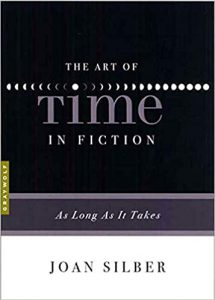By Marissa Dunham //

Today I am going to review The Art of Time in Fiction: As Long As It Takes by Joan Silber.
This column reviews books on the craft of writing. The intention is to provide new and veteran writers with resources to build their craft.
Time is a craft element that I think gets overlooked very easily by even veteran writers. I can’t tell you how many times I’ll be editing a story, and we’ve suddenly jumped from the present to the past mid-sentence or mid-paragraph. It’s not like time is hard to master. It’s that sustaining the same time across 10 pages or 250-plus pages is a workout on your curiosity. Hence the phrase, “kill your darlings.”
The Art of Time in Fiction is part of a series of books that takes one craft element and explores it in detail. I got the recommendation from Ruth Ozeki during a recorded master class hosted by Sarah Selecky. Ozeki is most recognized for the novel A Tale for the Time Being.
The Art of Time in Fiction is best for intermediate writers and for veterans in need of reminders. The book is short but dense. Not including “Works Discussed,” the book ends at page 112.
The Table of Contents has seven main chapters: “Classic Time,” “Long Time,” “Switchback Time,” “Slowed Time,” “Fabulous Time,” and “Time as Subject.” There is also an “Introduction” and “Works Discussed.”
Silber organizes the book based on her own definitions of time.
“Classic Time” is about how older stories would stay in one point of time and use elements in the present to stay in scene, like in Fitzgerald’s The Great Gatsby. “Long Time” is about stories that travel across decades or generations and talks about the importance of summary. “Switchback Time” is about switching sections of your story between two points of time, usually past and present. The author uses many examples from Alice Munro. But Amy Tan’s The Joy Luck Club would work just as well. “Slowed Time” is about stories that don’t have flashbacks and a few that rely on self-reflection. “Fabulous Time” is about stories that have nonrealistic time, like repetition or circular time. She gives a nod to magical realism at the beginning of “Fabulous Time,” but I think Gulliver’s Travels is as far as she actually gets into the fantasy genre. If you’re a fantasy writer, or any genre writer, I’d try and look at the advice in this chapter, and in this book, as general rather than genre-specific. “Time as Subject” is what it says. The chapter is about stories that explore time and memory as a main focus.
I don’t know if this is a warning exactly, but the book does lean a little academic in its explanations. You’ll get a phrase, like “a bit of rhetoric that invokes the cosmos in the services of sentiment” (31). Honestly, if that’s not your thing, I’d read right over it and get to the meat of the chapters. The examples are what you want.
Silber’s detailed breakdown of examples from published works will help you identify what kind of time appears in your story and give you a visual to keep your story consistent.
For those interested in a master of fine arts degree (but may not actually want to pursue one), The Art of Time in Fiction appears on some MFA required-reading lists. So if you want to get a head start on possible grad school or if you want to take your learning into your own hands, this is a book to add to your shelf.
When it comes to thinking about time in any genre, fiction or nonfiction, stay consistent. You have to be fully in the minds of your characters so that your readers can drop into your story without realizing how much good work you’ve done. And for time to work for you, you have to study it. That’s why I’ve included The Art of Time in Fiction in this column on reviewing books on the craft of writing. I want you to think about time when you’re writing. Your readers will love you for it.
What’s your favorite way of using time in stories?

MARISSA DUNHAM is a writer and freelance editor. She spent the early part of her career in educational publishing, but now spends most of her time editing literary fiction, magical realism, and middle grade fiction. She lives in Southern California, where she enjoys bringing new life into the world by planting tomatoes and flowers in the garden.


One Reply to “MARISSA’S TAKE ON: The Art of Time in Fiction: As Long As It Takes by Joan Silber”